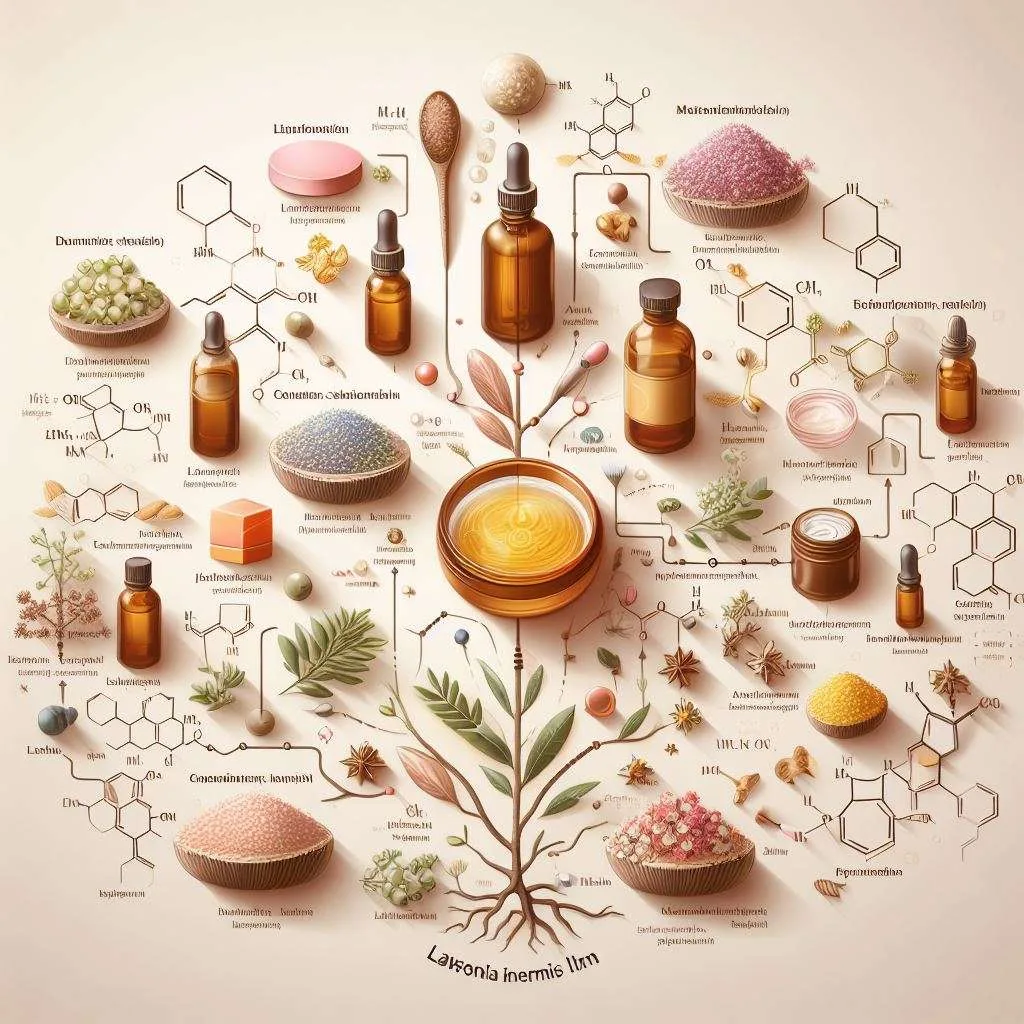Introduction: Is Lawsonia inermis Linn More Than Just Artistic Henna for the Skin?
Yes, absolutely. Growing up, I only knew henna for its beautiful, intricate designs. It was a staple at cultural events and a symbol of celebration. But as I delved deeper into cellular and molecular biology during my grad years, I stumbled upon henna’s lesser-known side, particularly its benefits for skin health. Through interactions with various colleagues, I became aware of age-old traditions where henna was revered not just for its art but also as a skincare remedy. It felt like discovering an old song had more verses than you knew.
The juxtaposition of “henna” with “skincare” intrigued me, and my scientific curiosity kicked in. So, what makes this ancient plant relevant in today’s skincare discussions? Is henna good for your skin? Let’s delve into the science behind the benefits of henna for skin.

The Science Behind Lawsonia inermis Linn: Unraveling Nature’s Beauty Secret
Often renowned for its henna benefits for skin, Lawsonia inermis Linn possesses a diverse range of compounds that contribute to its medicinal properties. There’s this heartwarming memory I often revisit from my early research days. Surrounded by beakers and flasks, I was attempting my first plant extraction. While it wasn’t Lawsonia inermis Linn I was working with that day, that hands-on experience made me appreciate the complexities of the botanical world even more.
Now, when you hear “Lawsonia inermis Linn,” you might conjure up the image of the greenish powder commonly used in henna tattoos. But if you look at it from a molecular viewpoint, this plant is truly an intricate puzzle. What is henna made of? Its leaves are brimming with various bioactive compounds like lawsone, flavonoids, and phenolic glycosides that grant it unique characteristics. Here’s a deeper dive:
- Lawsone (2-hydroxynaphthoquinone): Beyond imparting the characteristic reddish-brown color, it potentially soothes the skin 1.
- Other Compounds: The plant boasts flavonoids like apigenin, luteolin, and quercetin; phenolic glycosides; coumarins; xanthones; quinoids; beta-cytostrol; lipids; resins; tannins, and catechins 2.
- Secondary Metabolites: Lawsonia inermis Linn reveals a presence of cardioglycosides, terpenoids, carbohydrates, phenols, quinones, and more tannins upon phytochemical analysis 1. These especially, the phenolic compounds, contribute to its antimicrobial activity 1
- Additional Compounds: The plant also contains derivatives like fraxetin and 1(3H)-isobenzofuranone, enhancing its therapeutic portfolio 3.
Benefits of Lawsonia inermis Linn for Skincare: Nature’s Multifaceted Gift to Our Skin

Nature never ceases to amaze me. The more I learned about Lawsonia inermis Linn’s plethora of compounds, the more I was convinced about its potential in skincare and beyond. Think about it: a single plant contains such a diverse range of compounds that contribute to its medicinal and cosmetic properties. It’s like unearthing a treasure chest of nature’s best-kept secrets, making Lawsonia inermis Linn a valuable asset in both traditional and contemporary applications.
I’ve always believed that the most authentic stories come from personal experiences. Remember those teen years filled with acne battles? Or those times when the mirror reflected early signs of aging, even though you felt young at heart? I’ve been there, and I’ve often reached out for natural remedies. Enter Lawsonia inermis Linn, a natural solution known for its henna benefits for skin. The deeper I went into its world, the more I realized it wasn’t just a one-trick pony. From soothing inflammation to acting as a shield against aging, this plant seemed like nature’s very own Swiss army knife for skincare.
Anti-inflammatory properties: Nature’s Answer to Inflamed Skin
As the realms of tradition and modern science intersect, one of the standout benefits of henna that has captured both scientific and popular attention is its anti-inflammatory properties. As I delved deeper into the science behind henna, it vividly reminded me of my own acne episodes from years ago. Had I known about Lawsonia inermis Linn’s potential benefits then, I would have been intrigued to explore it as a natural remedy, along with aloe vera I guess… Understanding its unique henna uses makes one wonder about its uncharted potential in the realm of skincare.
When I started diving into its science, here’s what stood out:
- Phytochemical Powerhouses: Lawsonia inermis is enriched with phytochemicals like lawsone, quercetin, gallic acid, and kaempferol. These compounds aren’t just fancy names; they pack a punch by hindering the production of pro-inflammatory mediators, such as nitric oxide, prostaglandins, and cytokines 4,5. Think of them as the peacekeepers in a chaotic city, ensuring everything runs smoothly.
- Topical Benefits: Ever had those moments where your skin feels inflamed, and all you wish for is instant relief? Applying Lawsonia inermis, be it in paste or oil form, directly to the troubled areas can potentially ease redness, swelling, and discomfort 6,7.
- Immune System Balance: Our skin is a complex landscape, often influenced by our immune system’s responses. Lawsonia inermis may help strike a balance, preventing the overzealous activation of immune cells that can escalate inflammation and cause tissue damage 7.
- Guarding Against Oxidative Stress: On a day when everything feels overwhelming, a good song or a comforting chat can make all the difference. Similarly, Lawsonia inermis shields our skin from oxidative stress and free radical havoc, thanks to its antioxidant properties.
Lawsonia inermis Linn seems like a promising ally for inflamed skin. Whether it’s acne, psoriasis, or eczema, this plant offers a natural avenue worth exploring. But, as with all things skin-related, it’s always wise to touch base with a dermatologist. Because while nature offers bounties, our individual responses can vary, and some might experience allergic reactions or hypersensitivity.
Antioxidant Effects: Lawsonia inermis Linn’s Guard Against Time
I’ve always been fascinated by the concept of aging. It’s like watching a beautiful sunset; it’s inevitable, yet holds a unique charm. As I ventured deeper into my skincare exploration, the word ‘antioxidants’ frequently popped up, often tied to anti-aging benefits. But what are antioxidants, and why do they matter so much? Let’s unravel this.
One of the foremost henna benefits for skin is its antioxidant potency.
Antioxidants are the unsung heroes in the cellular world. Picture this: a serene city where every now and then, mischievous elements, known as free radicals, create chaos. These free radicals can harm DNA, proteins, and lipids within our cells, contributing to aging and even certain diseases like cancer and diabetes 8. Antioxidants are like the city’s guardians, intervening and preventing free radical-induced damage.
And guess what? Lawsonia inermis Linn, our spotlight plant, comes power-packed with these guardians. It houses phytochemicals such as lawsone, quercetin, gallic acid, kaempferol, and flavonoids 7, 9. What’s awe-inspiring is that these compounds don’t just fend off free radicals. They amplify the power of in-cell antioxidant enzymes, like superoxide dismutase and catalase. Moreover, by tweaking the expression of specific genes involved in the oxidative stress response, Lawsonia inermis Linn ensures a balanced cellular environment, preventing oxidative harm.
The benefits don’t stop at mere protection. Lawsonia inermis Linn wears multiple hats – from anti-inflammatory to anti-cancer and immunomodulatory effects. These roles combat chronic diseases associated with aging and inflammation. For those of us concerned with external aging signs (guilty as charged!), this plant might be the answer. Imagine reducing wrinkles, fading pigmentation, and warding off sunburns, all while stimulating hair growth. Sounds too good to be true, right? But that’s the beauty of nature.
Lawsonia inermis Linn, with its antioxidant prowess, emerges as a front-runner in the fight against aging and oxidative stress. It’s a testament to the timeless wisdom embedded in nature, promising improved health and quality of life. However, before we crown it as the ultimate elixir, more research is needed. It’s always essential to tread with curiosity but also caution.
Antimicrobial Activity: Lawsonia inermis Linn’s Protective Shield Against Pesky Pathogens
When it comes to henna benefits for skin, its antimicrobial properties can’t be overlooked. Far from being bad for your skin, Lawsonia inermis Linn is a natural alternative to conventional ointments for treating skin infections. Rich in phytochemicals like lawsone and quercetin, it acts as a natural antibiotic. In my view, its antimicrobial prowess makes it a compelling choice for natural skincare enthusiasts.
Lawsonia inermis Linn isn’t just about intricate designs or red tresses. Its core is brimming with phytochemicals like lawsone, quercetin, gallic acid, and kaempfero 1. These aren’t just random chemicals; they’re a formidable line of defense against various bacteria, fungi, viruses, and even parasites causing skin infections 7.10,11
- Phytochemical Protectors: At the heart of Lawsonia inermis Linn are phytochemicals like lawsone, quercetin, gallic acid, and kaempferol 1,7,10,11. These compounds play a pivotal role in hampering the growth of bacteria, fungi, viruses, and even some parasites. It’s like having a security detail for your skin, ensuring unwanted guests are shown the door.
- Bacterial Adversaries: Those painful skin conditions like boils, abscesses, and carbuncles? They’re often the handiwork of bacteria such as Staphylococcus aureus or E. coli 10,11,12 Lawsonia inermis Linn steps in to curtail their malicious plans, offering potential relief.
- Fungal Foes: Ever had the misfortune of athlete’s foot or ringworm? Fungi, including Candida albicans and Aspergillus spp., are to blame 10,11. Thanks to Lawsonia inermis Linn, these can be kept at bay.
- Viral Villains: Viruses, with their sneaky ways, can lead to conditions like chickenpox or herpes simplex 10,11. Our trusty Lawsonia inermis Linn acts as a shield, counteracting their efforts.
Summing it up, Lawsonia inermis Linn stands as a sentinel, guarding our skin against a myriad of pathogens. This reaffirms my belief in nature’s abundant solutions. However, like with all remedies, it’s essential to tread carefully. While this plant is a reservoir of benefits, always ensure it aligns with your skin’s needs, preferably under expert guidance. After all, every skin story is unique, and it deserves personalized care.
Natural Coloring Agent: Embracing Lawsonia inermis Linn’s Earthy Hues Over Synthetic Alternatives
In today’s world, where synthetic products often dominate the shelves, there’s a growing consciousness about reverting to nature’s offerings. Amidst the plethora of natural alternatives, one that stands out is henna, celebrated not just for its rich colors but for its multifaceted henna benefits for skin and hair
You see, the term “natural coloring agent” has an old-world charm to it. What is henna powder used for? It speaks of an era where colors were derived from the essence of plants, minerals or insects. It wasn’t just about aesthetics; it was about harmony with nature. And here’s why it matters:
- Environmentally Caring: Unlike synthetic dyes, predominantly sourced from non-renewable and polluting sources like petroleum, natural coloring agents like Lawsonia inermis Linn originate from renewable, biodegradable sources. This means lesser harm to our planet and a reduced carbon footprint 13.
- Gentle and Kind: Have you ever thought about the cocktail of chemicals in synthetic dyes? Some of them contain heavy metals, carcinogens, and other harmful substances. These can trigger allergic reactions and even impact our nervous system 6. Contrastingly, Lawsonia inermis Linn is gentle, and in many cultures, revered for its minimal side effects.
- Beyond Just Color: For a moment, imagine a dye that doesn’t just color but heals. That’s Lawsonia inermis Linn for you. Apart from its mesmerizing hues, it comes packed with benefits like anti-inflammatory, antimicrobial, and antioxidant properties (see above), elevating it from being just a coloring agent to a therapeutic companion.
So, as I pen this down, it’s not just about championing Lawsonia inermis Linn. It’s about making conscious choices that resonate with our ethos, health, and the environment. But, a word to the wise: nature is vast and varied, and while Lawsonia inermis Linn holds promise, ensure it aligns with your skin’s needs, perhaps under expert guidance.
Conclusion: Lawsonia inermis Linn – A Gift from Nature with Its Unique Story
Nature, in its boundless generosity, offers remedies that have been cherished and passed down through generations. Particularly, the Henna Benefits for Skin have piqued interest in the wellness community. Lawsonia inermis Linn stands as one such botanical wonder, celebrated for its potential skincare benefits. From its anti-inflammatory properties, which can be a solace for many skin woes, to its role as a natural coloring agent, it holds a special place in the realm of natural skincare.
But like any story with its highs and lows, Lawsonia inermis Linn too comes with its set of considerations. The quest for authenticity in products, understanding individual skin reactions, and seeking more comprehensive long-term studies are aspects we must navigate with care.

As we explore the enriching world of natural remedies, Lawsonia inermis Linn serves as a reminder of the delicate balance between tradition and modernity, efficacy and caution. It invites us to be both curious and informed, to appreciate nature’s offerings while being attentive to our unique needs.
For those considering introducing Lawsonia inermis Linn into their skincare regimen, it’s akin to beginning a new chapter in one’s wellness journey. With patience, observation, and a dash of wisdom, this journey promises to be as enlightening as it is enriching.
FAQ
Lawsonia inermis Linn is the scientific name for the henna plant, renowned for its skincare and medicinal properties.
Yes, henna has various skincare benefits, including anti-inflammatory, antimicrobial, and antioxidant properties.
Henna is made from the leaves of the Lawsonia inermis Linn plant, which contain bioactive compounds like lawsone, flavonoids, and phenolic glycosides.
While henna is generally considered safe, some individuals may experience allergic reactions or skin irritation. Always conduct a patch test before full application.
References
7 PHARMACOLOGICAL ACTIVITIES OF LAWSONIA INERMIS LINN.: A REVIEW
13.Oda, Y., Nakashima, S., Kondo, E. et al. Comparison of lawsone contents among Lawsonia inermis plant parts and neurite outgrowth accelerators from branches. J Nat Med 72, 890–896 (2018). https://doi.org/10.1007/s11418-018-1221-y
14..Amit Chauhan, Varsha Chauhan. Toxicity of Adulterants Mixed with Lawsonia Inermis Linn over Human Health. IJCRR – 13(14), July, 2021, Pages: 62-68
